Dodge Journey: Removal
2.4L
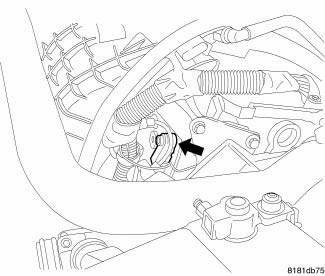
Fig. 45: Locating Knock Sensor
The knock sensor bolts into the side of the cylinder block in front of the starter under the intake manifold.
1. Disconnect and isolate negative battery cable.
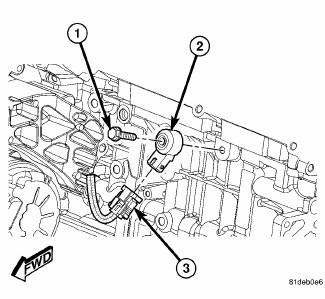
Fig. 46: 2.4L Knock Sensor
2. Disconnect electrical connector (3) from knock sensor (2).
3. Remove bolt (1) and knock sensor (2) from engine block.
2.7L
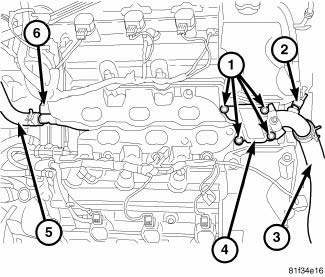
Fig. 47: Water Housing Outlet Tube 2.7L
- - Bolts
- - Coolant Temp Sensor Connector
- - Radiator Upper Hose
- - Water Housing Outlet Tube
- - Heater Hose
- - Retaining Clip
WARNING: Do not remove pressure cap with the system hot and under pressure because serious burns from coolant can occur.
1. Drain cooling system. 2. Disconnect and isolate the negative battery cable.
3. Remove lower intake manifold.
4. Remove radiator upper hose (3) at water housing outlet tube (4).
5. Remove heater hose (5) from water housing outlet tube (4) at rear of engine.
6. Disconnect water housing outlet tube (4) from retaining clip (6) at rear of engine.
7. Disconnect electrical connector (2) from coolant temperature sensor.
8. Remove 4 bolts (1) attaching water housing outlet tube (4) to cylinder heads.
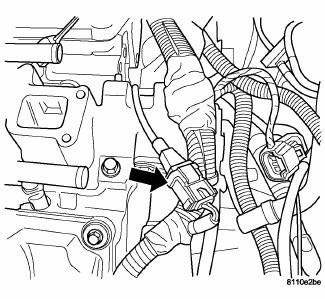
Fig. 48: Knock Sensor Connector
9. Disconnect electrical connector from knock sensor.
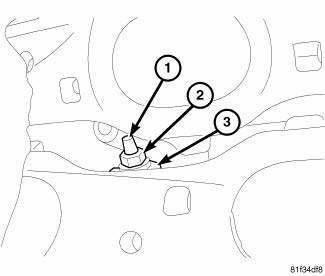
Fig. 49: Knock Sensor 2.7L
- - Stud
- - Nut
- - Knock Sensor
10. Reposition the water housing outlet tube and remove nut (2) from knock sensor mounting stud (1).
11. Remove knock sensor (3) from engine block.
3.5L
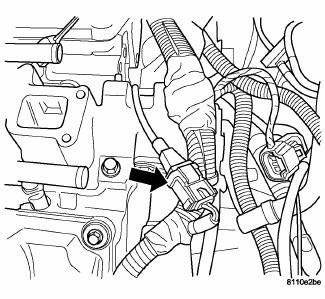
Fig. 50: Knock Sensor Connector
1. Disconnect the negative battery cable.
2. Remove the upper intake manifold.
3. Disconnect the electrical connector.
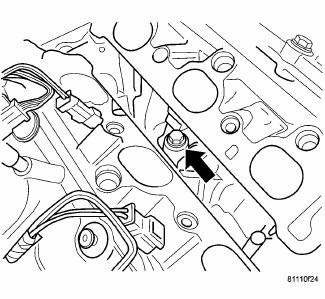
Fig. 51: Knock Sensor Location
4. Remove the knock sensor .
 Sensor, knock
Sensor, knock
...
 Installation
Installation
2.4L
Fig. 52: 2.4L Knock Sensor
CAUTION: Always torque knock sensors to the correct torque
specification. Over or
under tightening effects knock sensor performance. Ensure the electr ...
See also:
Seal(s), valve guide
REMOVAL
Fig. 139: Valve Stem Seal-Removal/Installation
- VALVE SEAL TOOL
- VALVE STEM
1. Remove valve spring.
2. Remove valve stem seal by using a valve seal tool.
INSTALLATION
Fig. ...
Installation
NOTE: Perform 1 through 6 on each side of vehicle to complete pad set
installation,
then proceed to 7.
CAUTION: Anytime the brake rotor or brake pads are being replaced,
the rear cal ...
Cover(s), cylinder head, right
REMOVAL
1. Disconnect negative battery cable.
Fig. 126: Engine Harness Retaining Clips
- Left cylinder head cover engine harness retainers
- Right cylinder head cover engine harness retainer ...
